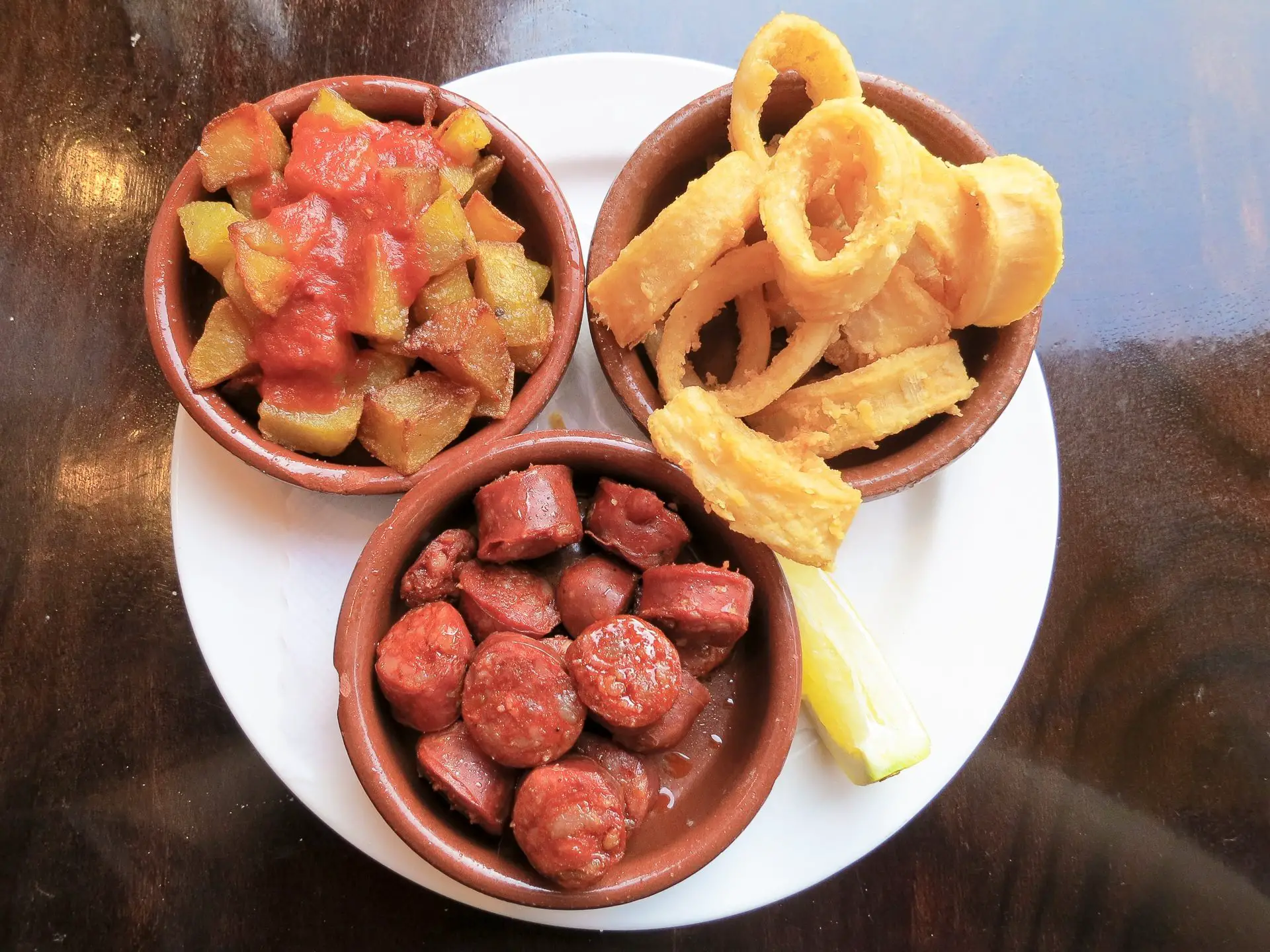Madrileños love their tapas. It’s almost impossible to walk around the streets of Madrid without running into at least a few tapas spots with outdoor seating.
Madrileños love their tapas. It’s almost impossible to walk around the streets of Madrid without running into at least a few tapas spots with outdoor seating.
A little history behind tapas: these tiny dishes were invented at Spanish medieval roadside inns and come from the Spanish verb tapar or, to cover. Innkeepers offered travelers a sample of the day’s dishes on a pot cover (tapa), and in modern day Spanish, tapa still refers to any small dish.
Here’s a rundown of those wonderful little dishes you have to try along with your wine, sangria, or Cava while in Madrid. Best of all, tapas are traditionally free with your drinks!
Save on Food Tours of Madrid ›
The basics
Olives, duh
You probably won’t even have to ask for a small plate of green (and sometimes black) pitted olives to be served up at your table, sometimes even before you put your wine order in. Spanish olives tend to have a less salty and more meaty taste than Greek or Italian ones. The ones you will mostly likely run into in Madrid are called Campo Real olives, and often taste of garlic and oregano and may be stuffed with tiny pieces of ham or bell pepper. Mmf!
Patatas Bravas

A comforting classic, patatas braves are chopped potatoes fried in olive oil, served with a spicy sauce, usually made from tomato and garlic but that can also be served with a garlicky aioli.
Croquetas

Deep fried potato croquettes coated in eggs and breadcrumbs with stuffing like bechamel cheese and chopped ham or shrimp … mm!
Prawns
Madrileños love their prawns, making them boiled, grilled, with beer sauce, or garlic.
Tortilla espanol

These tortillas are nothing like a Mexican corn tortilla, instead resembling more of a puffy potato and egg omelette. They can be stuffed with mushrooms, olives, ham, truffles, cheese, chicken or served vegetarian style.
Cured meats
Sliced hams (jamon) and salamis are what Madrid is all about. Look for the big haunches of hams in the windows that bartenders will slice into paper thin pieces. This is the city of the Museum of Ham, after all.
According to legend, pork is sacred. Spaniards had to eat pieces of ham or pork during the Spanish Inquisition to prove their devotion to Catholicism (as opposed to being an Islamic Moor).

Jamon iberico, or Iberian ham, is an expensive dry-cured ham made from Black Iberian pigs and are labeled based on quality, with purebred Black Iberian pigs and acorn fed pigs (jamon 100% iberico de bellota) being most desirable.
Jamon serrano is another variety of dry-cured ham less fatty than iberico and less expensive, often served sliced or cubed or as a bone-in ham.
Tostas

Thick slices of toast with toppings such as sweet or savory cheese, meats, honey, nuts, olives, anchovies, or mystery spreads. Very similar to Italian bruschetta.
Anything with chorizo
Madrid is a meat city, particularly any kind of pork that has been cured, fermented, or cased. Chorizo stew such as
Not mentioned: paella
Paella is a Valencian dish, and Madrid is a city far away from the coast. You can find paella in many spots, but it’s not really a Madrid speciality.
However, that shouldn’t disssuade you from trying any seafood whatsoever. Because of its Catholic roots, Madrid has a variety of seafood imported from all the surrounding coasts for their traditionally meat free Friday seafood meals.
Boquerones en vinagre
Spanish anchovies, or boquerones, are completely different than the overly salty and strong kind you’ve tasted if you are from the US. Boquerones in vinegar is a very popular starter dish in the summer months with beer rather than wine (since they already have vinegar).
For the adventurous
Oreja la plancha
Madrid style pork ears are prepared with lots of salt and garlic, and are usually fried and occasionally served with mushrooms or bacon.
Painstaking care is taken to raise Spanish pigs, so it’s respectful to eat every part of the pig possible.
Callos a la Madrileña
Callos is a stew made from beef trips and traditionally consumed in the winter months. This stew may be flavored with blood sausage, jamon and chorizo in a meat broth of tomato sauce, paprika, and garlic.
Caracoles a la Madrileña
Similar to French escargot, harvested locally and served in beef broth and garlic and jamon, served hot in spring with red wine.
Spots to try:
Mercado San Miguel
A beautiful indoor market filled with booths and benches for sampling the delectable foods you see stacked and hanging everywhere.
Plaza de San Miguel, s/n, 28005 Madrid, Spain
La Parajita
This bright green exterior leads to a small wine bar saturated with traditional Spanish decor and tchotchkes. Best olives I had in Madrid by far.
Calle Apodaca, 20, 28004 Madrid, Spain
Anywhere on Calle Cava Baja
This charming street is lined with amazing bars and restaurants that start opening for dinner at the traditional time of around 9–10PM. You can almost certainly find a pre-dinner tapas bar to shack up in until your evening meal.
Museo del Jamon
Yes, a museum of ham. More like a ham themed chain of restaurants, but nothing wrong with that, right?
Multiple Locations
Madrid is the capital of one of the most gastronomically diverse countries on the planet. Hopefully this short guide points you to some amazing eats!
Pin it:

Post contains affiliate links.





[…] Heading to Madrid sometime soon? Check out my guide to tapas dishes you have to try in Madrid! […]